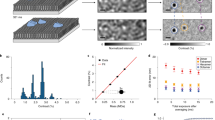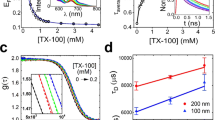Abstract
There is accumulating evidence that the small-scale lateral organization of biological membranes has a crucial role in signaling and trafficking in cells. However, it has been difficult to characterize these features with existing methods for preparing and analyzing freestanding membranes, because the dynamics occurs below the optical resolution possible with these protocols. We have developed a protocol that permits the imaging of lipid nanodomains and lateral protein organization in membranes of giant unilamellar vesicles (GUVs). Freestanding GUVs are transferred onto a mica support, and after treatment with magnesium chloride, they collapse to form planar lipid bilayer (PLB) patches. Rapid GUV collapse onto the mica preserves the lateral organization of freestanding membranes and thus makes it possible to image 'snapshots' of GUVs up to nanometer resolution by high-resolution microscopy. The method has been applied to classical lipid raft mixtures in which suboptical domain fluctuations have been imaged in both the liquid-ordered and liquid-disordered membrane phases. High-resolution scanning by atomic force microscopy (AFM) of membranes composed of binary and ternary lipid mixtures reconstituted with Na+/K+-ATPase (NKA) has revealed the spatial distribution and orientations of individual proteins, as well as details of membrane lateral structure. Immunolabeling followed by confocal microscopy can also provide information about the spatial distribution of proteins. The protocol opens up a new avenue for quantitative biophysical studies of suboptical dynamic structures in biomembranes, which are local and short-lived. Preparation of GUVs, PLB patches and their imaging takes <24 h.
This is a preview of subscription content, access via your institution
Access options
Access Nature and 54 other Nature Portfolio journals
Get Nature+, our best-value online-access subscription
$29.99 / 30 days
cancel any time
Subscribe to this journal
Receive 12 print issues and online access
$259.00 per year
only $21.58 per issue
Buy this article
- Purchase on Springer Link
- Instant access to full article PDF
Prices may be subject to local taxes which are calculated during checkout





Similar content being viewed by others
References
Simons, K. & Ikonen, E. Functional rafts in cell membranes. Nature 387, 569–572 (1997).
Hanzel-Bayer, M.F. & Hancock, J.F. Lipid rafts and membrane traffic. FEBS Lett. 581, 2098–2104 (2007).
Brown, D.A. & London, E. Structure and function of sphingolipid- and cholesterol-rich membrane rafts. J. Biol. Chem. 275, 17221–17224 (2000).
Eggeling, C. et al. Direct observation of the nanoscale dynamics of membrane lipids in a living cell. Nature 457, 1159–1162 (2009).
Ringemann, C. et al. Exploring single-molecule dynamics with fluorescence nanoscopy. New J. Phys. 11, 103054 (2009).
Ipsen, J.H., Jorgensen, K. & Mouritsen, O.G. Density fluctuations in saturated phospholipid bilayers increase as the acyl-chain length decreases. Biophys. J. 58, 1099–1107 (1990).
Gil, T. et al. Theoretical analysis of protein organization in lipid membranes. Biochim. Biophys. Acta 1376, 245 (1998).
Hønger, T. et al. Anomalous swelling of multilamellar lipid bilayers in the transition region by renormalization of curvature elasticity. Phys. Rev. Lett. 72, 3911–3914 (1994).
Cruzeiro-Hansson, L., Ipsen, J.H. & Mouritsen, O.G. Intrinsic molecules in lipid-membranes change the lipid-domain interfacial area: cholesterol at domain interfaces. Biochim. Biophys. Acta 979, 166–176 (1989).
Vist, M. & Davis, J. Phase-equilibria of cholesterol dipalmitoylphosphatidylcholine mixtures—H2 nuclear magnetic-resonance and differential scanning calorimetry. Biochemistry 29, 451–464 (1990).
Almeida, P., Vaz, W. & Thompson, T. Lateral diffusion in the liquid-phases of dimyristoylphosphatidylcholine cholesterol lipid bilayers—a free-volume analysis. Biochemistry 31, 6739–6747 (1992).
Gowrishankar, K. et al. Active remodeling of cortical actin regulates spatiotemporal organization of cell surface molecules. Cell 149, 1353–1367 (2012).
Dietrich, C., Yang, B., Fujiwara, T., Kusumi, A. & Jacobson, K. Relationship of lipid rafts to transient confinement zones detected by single particle tracking. Biophys. J. 82, 274–284 (2002).
Tokumasu, F., Jin, A., Feigenson, G. & Dvorak, J. Nanoscopic lipid domain dynamics revealed by atomic force microscopy. Biophys. J. 84, 2609–2618 (2003).
Dietrich, C. et al. Lipid rafts reconstituted in model membranes. Biophys. J. 80, 1417–1428 (2001).
Tamm, L. & McConnell, H. Supported phospholipid-bilayers. Biophys. J. 47, 105–113 (1985).
Milhiet, P., Giocondi, M. & Grimellec, C. AFM imaging of lipid domains in model membranes. Sci. World J. 17, 59 (2003).
Alessandrini, A. & Facci, P. Phase transitions in supported lipid bilayers studied by AFM. Soft Matter 10, 7145–7164 (2014).
Heinemann, F. & Schwille, P. Preparation of micrometer-sized free-standing membranes. Chem. Phys. Chem. 12, 2568–2571 (2011).
Papahadjopoulos-Sternberg, B. Freeze-fracture electron microscopy on domains in lipid mono- and bilayer on nano-resolution scale. Methods Mol. Biol. 606, 333–349 (2010).
Bhatia, T., Husen, P., Ipsen, J.H., Bagatolli, L.A. & Simonsen, A.C. Fluid domain patterns in free-standing membranes captured on a solid support. Biochim. Biophys. Acta 1838, 2503–2510 (2014).
Bhatia, T. et al. Spatial distribution and activity of Na+K+-ATPase in lipid bilayer membranes with phase boundaries. Biochim. Biophys. Acta 1858, 1390–1399 (2016).
Jass, J., Tjärnhage, T. & Puu, G. From liposomes to supported planar bilayer structures on hydrophilic and hydrophobic surfaces: an atomic force microscopy study. Biophys. J. 79, 3153–3163 (2000).
Horn, R.G. Direct measurement of the force between two lipid bilayers and observation of their fusion. Biochim. Biophys. Acta 778, 224–228 (1984).
Richter, R.P. & Brisson, A.R. Following the formation of supported lipid bilayers on mica: a study combining AFM, QCM-D, and ellipsometry. Biophys. J. 88, 3422–3433 (2005).
Hamai, C., Cremer, P.S. & Musser, S.M. Single giant vesicle rupture events reveal multiple mechanisms of glass-supported bilayer formation. Biophys. J. 92, 1988–1999 (2007).
Xie, Z. Molecular mechanisms of Na+,K+-ATPase mediated signal transduction. Ann. N. Y. Acad. Sci. 986, 497–503 (2003).
Skou, J. The influence of some cations on an adenosine triphosphatase from peripheral nerves. Biochim. Biophys. Acta 23, 394–401 (1957).
Cornelius, F. In Biomimetic Membranes for Sensor and Separation Applications, Biological and Medical Physics, Biomedical Engineering (ed. Hèlix-Nielsen, C.), 6, 113–135 (Springer, 2012).
Cornelius, F., Habeck, M., Kanai, R., Toyoshima, C. & Karlish, S.J.D. General and specific lipid-protein interactions in NaK-ATPase. Biochim. Biophys. Acta 1848, 1729–1743 (2015).
Cornelius, F. Functional reconstitution of the sodium pump kinetics of exchange reactions performed by reconstituted NaK-ATPase. Biochim. Biophys. Acta 1071, 19–66 (1991).
Kanai, R., Ogawa, H., Vilsen, B., Cornelius, F. & Toyoshima, C. Crystal structure of a Na+-bound Na+K+-ATPase preceding the E1P state. Nature 502, 201–206 (2013).
Shinoda, T., Ogawa, H., Cornelius, F. & Toyoshima, C. Crystal structure of the sodium-potassium pump at 2.4 Å resolution. Nature 459, 446–450 (2009).
Bhatia, T. et al. Preparing giant unilamellar vesicles of complex lipid mixtures on demand: mixing small unilamellar vesicles of compositionally heterogeneous mixtures. Biochim. Biophys. Acta 1848, 3175–3180 (2015).
Bhatia, T., Cornelius, F., Mouritsen, O.G. & Ipsen, J.H. Reconstitution of transmembrane protein Na+,K+-ATPase in giant unilamellar vesicles of lipid mixtures involving PSM, DOPC, DPPC and cholesterol at physiological buffer and temperature conditions. Protoc. exch. http://dx.doi.org/10.1038/protex.2016.010 (2016).
Husen, P., Arriaga, L.R., Monroy, F., Ipsen, J.H. & Bagatolli, L.A. Morphometric image analysis of giant vesicles, a new tool for quantitative thermodynamics studies of phase separation in lipid membranes. Biophys. J. 103, 2304–2310 (2012).
Husen, P., Arriaga, L.R., Monroy, F., Ipsen, J.H. & Bagatolli, L.A. A method for analysis of lipid vesicle domain structure from confocal image data. Eur. Biophys. J. 41, 161–175 (2012).
Fidorra, M., Garcia, A., Ipsen, J.H., Härtel, S. & Bagatolli, L.A. Lipid domains in giant unilamellar vesicles and their correspondence with equilibrium thermodynamic phases: a quantitative fluorescence microscopy imaging approach. Biochim. Biophys. Acta 1788, 2142–2149 (2009).
Bhatia, T., Cornelius, F. & Ipsen, J.H. Exploring the Raft-hypothesis by probing planar bilayer patches of free-standing giant vesicles at nanoscale resolution, with and without Na,K-ATPase. Biochim. Biophys. Acta 1858, 3041–3049 (2016).
Cornelius, F. Incorporation of C12E8-solubilized Na+,K+-ATPase into liposomes, determination of sidedness and orientation. Methods Enzymol. 156, 156–167 (1988).
Cornelius, F. & Moller, J.V. In Handbook of Non-medical Applications of Liposomes Vol. 2 (eds. Lasic, D.D. & Barenholz, Y.) 219–243 (CRC Press, 1995).
Cornelius, F. Cholesterol dependent interaction of polyunsaturated phospholipids with NaK-ATPase. Biochemistry 47, 1652–1658 (2008).
Powalska, E. et al. Fluorescence spectroscopic studies of pressure effects on NaK-ATPase reconstituted into phospholipid bilayers and model raft mixtures. Biochemistry 46, 1672–1683 (2007).
Honerkamp-Smith, A.R. et al. Line tensions, correlation lengths, and critical exponents in lipid membranes near critical points. Biophys. J. 95, 236–246 (2008).
Palmieri, B. et al. Line active molecules promote inhomogeneous structures in membranes: theory, simulations and experiments. Adv. Colloid Interface Sci. 208, 58–65 (2014).
Safran, S. Micelles Membranes Microemulsions and Monolayers. Springer, 1994.
Charras, G.T., Coughlin, M., Mitchison, T.J. & Mahadevan, L. Life and times of a cellular bleb. Biophys. J. 94, 1836–1853 (2008).
Møller, J.V. et al. Probing of the membrane topology of sarcoplasmic reticulum Ca2+-ATPase with sequence-specific antibodies. J. Biol. Chem. 272, 29015–29032 (1997).
Muller, D.J. & Engel, A. Atomic force microscopy and spectroscopy of native membrane proteins. Nat. Protoc. 2, 2191–2197 (2007).
Veatch, S.L., Polozov, I.V., Gawrisch, K. & Keller, S.L. Liquid domains in vesicles investigated by NMR and fluorescence microscopy. Biophys. J. 86, 2910–2922 (2004).
Apell, H.J. & Bersch, B. Oxonol VI as an optical indicator for membrane potentials in lipid vesicles. Biochim. Biophys. Acta 903, 480–494 (1987).
Peterson, G.L. A simplification of the protein assay method of Lowry et al. which is more generally applicable. Anal. Biochem. 83, 346–356 (1977).
Lowry, O.H. Protein measurement with the Folin phenol reagent. J. Biol. Chem. 193, 265–275 (1951).
Baginski, E.S., Foa, P.P. & Zak, B. Microdetermination of inorganic phosphate, phospholipids, and total phosphate in biologic materials. Clin. Chem. 13, 326–332 (1967).
Acknowledgements
We thank DAMBIC (Danish Molecular Bioimaging Center) for access to equipment. This work was supported by the Danish Council for Independent Research–Natural Sciences (FNU; grant 95-305-23443 to J.H.I. and F.C.), the Human Frontier Science Program (HFSP; grant 95-305-73458 to J.H.I.) and the Novo Nordisk Foundation (grant DFF-418300011 to F.C.), T.B. acknowledges O.G. Mouritsen (SDU), A.C. Simonsen (SDU), P.L. Hansen (SDU), L.A. Bagatolli (SDU), J. Brewer (SDU), L. Duelund (SDU), B. Franchi (AU) and H. Kidmose (AU) for useful discussions.
Author information
Authors and Affiliations
Contributions
T.B. performed the research and analyzed the data; designed the vesicle collapse method and developed it through many useful discussions with J.H.I.; and developed the SUV-mixing method together with J.H.I. F.C. prepared and characterized proteoliposomes for their functional and structural properties; prepared the primary antibodies for NKA; and discussed the protein-reconstitution protocol, antibody-labeling experiments and NKA data with T.B. J.H.I. planned the experiments with T.B. and contributed to data interpretation. T.B. and J.H.I. wrote the paper.
Corresponding author
Ethics declarations
Competing interests
The authors declare no competing financial interests.
Supplementary information
Time sequences showing GUV collapse after the addition of MgCl2 salt
The starting frame (t = 0 s) shows GUVs of ternary lipid mixture DOPC-DPPC-chol (30-50-20)% sitting on mica substrate displaying macroscopic ld (bright) and lo (dark) domains. There is no MgCl2 salt present in the fluid chamber. GUV collapse starts at t ∼ 3.820 s after the addition of MgCl2 salt, and planar lipid bilayer patches are formed that retain macroscopic ld (bright) and lo (dark) domains. GUVs contain the membrane probe RhPE, which preferentially partitions into the ld phase and is imaged as a bright region in GUVs and patches. GUVs were imaged in an epifluorescence microscope equipped with an EMCCD camera. Scale bar, 10 μm. Reproduced with permission from ref. 21. (AVI 1577 kb)
Rights and permissions
About this article
Cite this article
Bhatia, T., Cornelius, F. & Ipsen, J. Capturing suboptical dynamic structures in lipid bilayer patches formed from free-standing giant unilamellar vesicles. Nat Protoc 12, 1563–1575 (2017). https://doi.org/10.1038/nprot.2017.047
Published:
Issue Date:
DOI: https://doi.org/10.1038/nprot.2017.047
This article is cited by
-
Transient interactions drive the lateral clustering of cadherin-23 on membrane
Communications Biology (2023)
-
Micromechanics of Biomembranes
The Journal of Membrane Biology (2022)
Comments
By submitting a comment you agree to abide by our Terms and Community Guidelines. If you find something abusive or that does not comply with our terms or guidelines please flag it as inappropriate.



